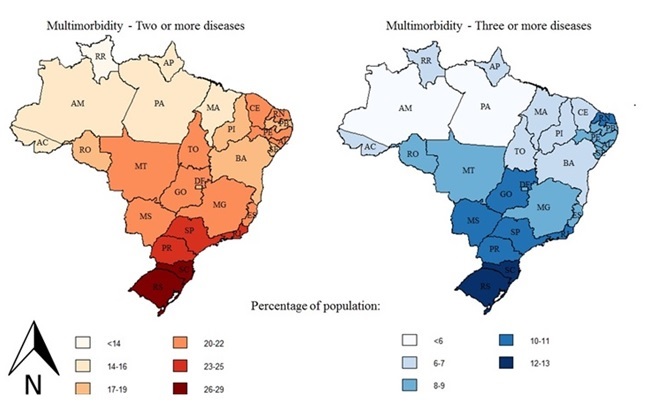By Bruno P Nunes and Sandro R Rodrigues Batista
In this paper, we evaluate the magnitude of multimorbidity in 60202 Brazilian adults, including the assessment of individual and contextual (state level) variables. The Brazilian national-based study was carried out in 2013. Multimorbidity was evaluated by a list of 22 physical and mental morbidities. Factor analysis and multilevel models were used to analyze the data. Multimorbidity frequency was 22.2% for ≥2 morbidities and 10.2% for ≥3 morbidities. For the whole Brazilian population, at least 41 and 19 million adults had multimorbidity, according ≥2 and ≥3 morbidities, respectively. The occurrence was different among states, being higher in southern Brazil (see below the Supplementary_figure_1). Contextual and individual social inequalities were observed.
To access the manuscript, please click in the following link:
Reference: Nunes BP, Chiavegatto Filho ADP, Pati S, Cruz Teixeira DS, Flores TR, Camargo-Figuera FA, Munhoz TN, Thumé E, Facchini LA, Rodrigues Batista SR. Contextual and individual inequalities of multimorbidity in Brazilian adults: a cross-sectional national-based study BMJ Open 2017;7:e015885. doi: 10.1136/bmjopen-2017-015885
By Bruno P Nunes and Sandro R Rodrigues Batista
We are very satisfied to inform the International Research Community on Multimorbidity (an important encouraging community of our work) about the creation of the Brazilian Group of Studies about Multimorbidity (named in Portuguese: Grupo Brasileiro de Estudos sobre Multimorbidade – GBEM). The group is headed by Bruno P Nunes and Sandro R Rodrigues Batista, two researchers from Brazil. The group is already formalized in the Brazilian national research platform of the Brazilian National Council for Scientific and Technological Development
Furthermore, we are described in ResearchGate too
Currently, we have more than 20 Brazilian researchers and some international collaborators, including researchers from Chile, Colombia, EUA, India, Peru, Portugal and Sri Lanka. One of our research goals as a group is to improve epidemiological information about multimorbidity in Low and Middle Income Countries, mainly in Brazil and South America. We are using a platform for planning our work and intend to publish the first scientific results of the partnership by the end of 2017. The articles already published by group members can be viewed in the ResearchGate website. Furthermore, we are looking for researchers interested in cross-country comparisons about a wide range of issues related to multimorbidity (prevalence, patterns, inequalities, use of health services and others) to be included in the GBEM. Contact e-mail for further information: nunesbp@gmail.com/ sandrorbatista@gmail.com/ gbemulti@gmail.com.
By Bruno P. Nunes

We are very satisfied to disseminate another recent paper about multimorbidity from Brazil in International Research Community on Multimorbidity (IRCMo) site. In this paper, we explore the occurrence and patterns (through Factorial Analysis) in Brazilian adults [1]. The manuscript used data from a population-based study carried out in 2012 in the individuals (20 or more years) households living in Pelotas, southern Brazil. Multimorbidity was evaluated by a list of 11 morbidities (based on medical diagnosis; Patient Health Questionnaire 9 for depression; and Anatomical Therapeutic Chemical index). The sample was made up of 2927 adults. Multimorbidity reached 29.1 % (95 % CI: 27.1; 31.1) for ≥2, and 14.3 % (95 % CI: 12.8; 15.8) for ≥3 morbidities. Two patterns of morbidities (cardio-metabolic and joint problems; and respiratory diseases) were observed. The high frequency and the observed patterns increase the need to address multimorbidity in Brazilian health policies and diseases guidelines.
To access the manuscript, please click in the following link:
Furthermore, we reinforce our invite to researchers interested in cross-country comparisons about a wide range of issues related to multimorbidity (prevalence, patterns, inequalities, use of health services and others). Contact e-mail for further information: nunesbp@gmail.com.
Reference:
1) Nunes BP, Camargo-Figuera FA, Guttier M, de Oliveira PD, Munhoz TN, Matijasevich A, Bertoldi AD, Wehrmeister FC, Silveira MP, Thumé E, Facchini LA. Multimorbidity in adults from a southern Brazilian city: occurrence and patterns. Int J Public Health. 2016 Apr 22. [Epub ahead of print]
February 3, 2016 – 2:31 pm
By Bruno P. Nunes, Elaine Thumé, and Luiz A. Facchini

We are very satisfied to disseminate our recent paper in International Research Community on Multimorbidity (IRCMo) site. This community was and continues to be very important for our studies related to this topic in Brazil.
Despite worldwide importance of multimorbidity and the specific Brazilian context (more than 200 million inhabitants, rapid epidemiologic and demographic transitions, and relatively new universal health system), populational information about occurrence of multiple health problems is scarce in the country. Thus, data from a population-based survey that we conducted in 2008 were used to provide information and start works about multimorbidity in Brazilian context. The sample was comprised by 1593 elderly (≥60 years old) who lived in Bagé, a medium-sized city in Southern Brazil. The individuals were interviewed in their households through face-to-face interviews. In total, 17 morbidities were used and we measured multimorbidity according to two cutoff points: ≥2 and ≥3 morbidities. Descriptive analysis, and dyads and triads of diseases were calculated. We found that 94% of the sample presented, at least, one morbidity. High blood pressure – HBP – (55.3%) and spinal column disease (37.4%) were the diseases most frequent. Multimorbidity reached 81.3% (95 % CI: 79.3; 83.3) and 64.0 % (95% CI: 61.5; 66.4) of the individuals for ≥2 and ≥3 morbidities, respectively. As found in others studies, most vulnerable elderly presented higher occurrence of multiple diseases. For example, 87.1% of the elderly without schooling presented 2 or more diseases (22.3 percentage points higher than elderly which studied 8 years or more). Another challenge to public health system was demonstrated by higher frequency of multimorbidity between individuals without health private plan and those who are living in Family Health Strategy (organizational axis of primary health care) catchment areas.
These results about multimorbidity in older adults from Brazil may provide initial information to address multiple diseases in clinical protocols and contribute to subsidize actions in health services to management of multimorbidity.
Furthermore, we are drafting others papers about multimorbidity in Brazil, including evaluation of national-based studies. Therefore, we would like to invite researchers interested in cross-country comparisons about a wide range of issues related to multimorbidity (prevalence, patterns, inequalities, use of health services and others) to contact us. Contact e-mail for further information: nunesbp@gmail.com.
- Reference: Nunes BP, Thumé E, Facchini LA: Multimorbidity in older adults: magnitude and challenges for the Brazilian health system. BMC Public Health 2015, 15(1):1172





